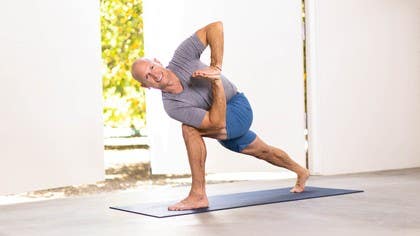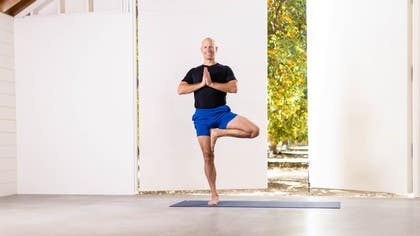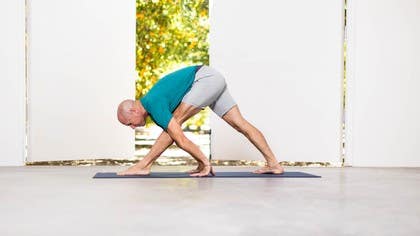Description
About This Video
Transcript
Read Full Transcript
Hello and welcome back. Great to have you here. In this lesson we're going to dive deeper into the core muscles and how they support twists. In twists, when we use the core muscles and learn how to set the pelvis, it creates an incredible lift throughout the body and especially in the abdominal organs. Just want to mention that if you have a block with you, it could be useful in a few of our poses, so have that on standby. We're going to start out lying down on the floor with knees bent. Please join me there. And let's take a minute to just relax and we'll settle into the practice. And then join me in resting the palms down in the lower abdomen and we'll bring some focus to the core muscles. And we'll start by doing a few pelvic tucks, which means press the waistband back into the floor. Release and again, pelvic tuck to push the waistband back in the floor. And this is just to bring some awareness, some muscle activation to this area of the body. A couple more. Press and release. Press and release. And then to add to the awareness, we're going to put the palms on the thighs and push into the thighs. This again is to help create more awareness for the area as we once again press the waistband into the floor and then release. Again, push back into the floor and release. As you continue to do this work, see how using the hands draws even more attention to the engagement of the core muscles. And then let's shift it just a little bit. Instead of pushing back with the waistband into the floor, we're going to go side to side with the hands still on the thighs. That creates a little bit more awareness as we move. I hike my left hip towards left shoulder and right hip toward right shoulder back and forth a few more times. And this brings awareness more to the obliques of the abdominal support system. The obliques. A couple more. Let that go and take the hands down to the sides of your mat and hold on strongly. We're going to raise the legs up into tabletop, knees together if you can. From here, we go back to pressing the waistband into the floor and releasing. Press and release. The key to this version is keeping the legs quiet and still. It's tempting to pull the knees into the chest. Instead, we're going to keep them still and try to exclusively move the pelvis only. A couple more. And then last one. And set the legs down. Take a little pause. Next, we're going to use that muscularity here, the muscle system, to create twists. We'll start by taking the arms out sideways and roll the knees into the chest. We'll start this by curling in just like we've done. Push the waistband into the floor and that creates a nice tight hold here in the abdominal area. Take a breath in, roll the legs to the left as though to put your knees in the left elbow. Hover just off the floor. Relax your neck and come back to center. We'll set the feet down for a moment. Reset. And then knees toward the chest. A breath in and a breath out to curl the knees. Use your abdominals to curl the knees toward the chest. Now we roll the legs towards the right elbow. And hold there. Just off the floor. We keep the knees tightly tucked in the entire time. Come back to center. Feet down for a little pause. And then we'll add just a little bit of a level up to this version. Knees into the chest. Right leg to the ceiling. We're going to keep the legs close together. A breath in and a breath out to curl the knees in towards the chest. And once again, we're going to roll the legs to the left as though to put your right foot into the left hand. Soft neck. Active arms. Active abdominals. Come back. Set the feet down to take a quick break. And then second side. Knees roll to the chest this time. Left leg up. We'll keep the legs close together. A breath in and a breath out to roll the knees in towards the chest. And now we go off to the right side. In this case, trying to put the foot into the right hand.
Hover just above. And then come back. Feet down to rest. You can bring the arms alongside you. I'm going to sway the legs a little left, a little right to release and relax. And a couple more times. And then to center. Let's turn to the side and come up. And we'll go to an all fours position for thread the needle. For this pose, feet together and knees apart about mat width. We'll start with the left arm. Tuck the left arm underneath your body. Shoot it through. Set the left shoulder down and the head down if you can. And then as we were doing before with the pelvic tucks, we're going to gently raise the waistband up to the ceiling until you might feel a little bit of the abdominal muscles engage. Take that cue and tighten them just a little bit to deepen your twist. And then relax a little. We'll do it one more time. Waistband rolling up towards the ceiling. You feel the abdominal muscles kick on a little. And they help us to twist a little deeper. And then unwind. We'll do the other side. Right arm comes through. Set the right shoulder down and head down if you can. And once again, we'll roll the waistband up just a little. And then I start to feel the abdominal muscles on the right side of the body engage a little. Left side starts on and they help me take the twist a little deeper. Soften one more time. Waistband up. Connect to your abdominals and turn a little deeper. You can push your right arm into the floor to help. And then release. We'll come back to all fours, tuck the toes, and come up into a downward facing dog. First dog of the day. Start by pedaling out the legs. One heel presses into the floor. One knee bends. Just a nice way to move the joints. Open some things up and get the body moving. While you're doing your pedaling, check that your arm bones are lifting up. I'm doing that now. Lifting the arm bones up so that the shoulders are well supported. Couple more. And then both heels down for just a moment.
Arm bones up. And next we'll come to a kneeling lunge. Right foot forward. Left knee down. And here we start to really explore how the abdominal muscles are going to support the twists of the day. To start, I'm going to put both my hands on top of the right thigh and push down. When I push down, I'm going to raise my right leg up. Can you see that happening there? That lift? So together. I use my hands as resistance and lift the leg up and now I can feel my abdominal muscles starting to engage. And this is what really helps us in the twists. Add to that a little pelvic tuck and we're ready. Leg pressing up to the hands. Hands pressing on the legs. A little bit of a pelvic tuck and now I turn. And my hope is here when you see I turn that my abdominals are wrapping around here. They're going in and up. Then maintain that. We're going to take the left elbow and lock that twist in place. Use that elbow. Lock the twist in place. Palm to palm now. Press the elbow into the thigh. See if you can turn a little bit more from the actual abdominal area. Turn. I'm doing that now. You can see that twist and I'm going to dip the shoulders just a little bit deeper. We did it. Come out and now we're going to change right into the second side. Left leg is forward. Two hands on the thigh. You kind of get a back view of how this works now. I'll push the hands into the thigh. Thigh up into the hands and then you can see I do my little gentle pelvic tuck. This helps me get the feeling of a lifting of the abdominals. I create my twist. Remember the feel in the twist is that the center, the core lifts backward and up toward the heart. There's the twist. Use the right elbow against your left thigh to lock in your twist. Let palm to palm and take the pose a little deeper. A little deeper twist by turning the abdomen up. Dip the shoulders a little lower and then release. Hands to the floor. Tuck the back foot. Let's go back to dog pose for just a moment. A little tail tuck to roll through the spine. Bend the elbows. Take the trunk to the floor. Point your toes. A little baby cobra. Curl your toes. Back up the down dog. Feet together. Raise your heels. Right foot forward again. We're going to get a deeper look at this twist. Add a little challenge to it. Same beginnings. Push on the thigh. Little pelvic tuck. Turn and hook your elbow to lock in your twist. Palm on palm. Take it a little deeper. Abdominals back and up. Holding here. Brain in the back foot. Push down and lift. Now here's the work in the pose. That gentle tuck. I'm going to do that now. Here it comes. That tuck right there helps connect me to the abdominals and allows me to turn from the right place. Touch down your knee. Release your hands and unwind.
Let's go back through a dog pose. Unwind the body a little. We'll roll through the plank. Bend the elbows. All the way to the floor. Point your toes. And a little baby cobra. Let down your chest. Tuck your toes. And dog pose again. Take a few breaths here. Allow the abdomen to be soft. Let the breath move into the abdomen. And as always, we'll keep those shoulder bones nice and lifted. Then looking forward, feet together, raise your heels. Left foot forward and drop the right knee down. We'll come up and do the work on the other side. Hands on the thigh. Push down on the thigh and lift up against that resistance. Create your turn. Remember that mild little pelvic tuck that helps you feel that upward lift. If you go too far, it'll become pretty obvious because you'll start to shrink in your pose. Just a little tuck to feel the lift of the front of the abdomen. Right elbow locks to left leg to keep the twist in place. And palm on palm. Deepen your twist a little. Here comes the challenge. Right foot tucks under. And can you straighten and lift the back leg? This is my challenge side. I'm a little bit more wobbly on this side. It takes a little extra focus for me. And then as I showed on the other side, here it comes. A little extra pelvic tuck. It's happening now. I'm moving there. It's subtle, but it helps the twist and it gets your support system in place. Then lower the knee. Unlock the twist. And let's again, set back to down dog. We'll curl the tail to help roll into plank and engage the abdomen. Slowly down to the floor. Point your toes into a baby cobra. Release the cobra. Tuck your toes. We're coming into down dog with a little extra flare this time. Feet together. Raise your heels. And the right leg comes up high.
We'll add the twist here. Turn in the pelvis open to the right side. Again, with a little bit of the pelvic tuck in place. And then back down. Lower the heels for a moment. And one more time. Heels up. Raise the left leg. Remember those shoulder bones always lifting. Turn the hips open to the left side. Little tiny bit of a pelvic tuck here helps you engage the entire core and support your pose. Foot back down. Lower the knees. And let's take a restful child's pose to recover. And then we'll come back up once again into a downward dog and we'll move towards some standing poses. Tuck the toes. Lift your knees. Shoulder bones, arm bones lifting. That gives us the support so we can move the chest up towards the hips. Relax your head. Relax your neck. And then lift your heels. We'll step forward to the front of the mat. Tadasana. In your tadasana pose, let's work together in creating that cycle of energy that we worked on in the previous lesson. To do that, a micro pelvic tuck waistband goes back. And the things we're looking for here, we feel the hamstrings start to engage. The front body is lifting all the way up to the collar bones. And we feel a grounding, a rooting down through the heels. And then we'll use what we've been working on to add to the chair pose. Let's start by bending the knees, hands on the thighs, and this gives us a little bit of resistance so that we can feel the pelvis and the abdominal muscle support. Gently, gently tuck the pelvis, waistband backward just a little bit. And now I feel the hamstrings have started to engage and support the pose. We're going to turn to the right side first. Like before, I have resistance with my right hand, and then I hook and lock in the twist with my left elbow. Palm on palm. Then I want you to bring attention to my abdomen here as I turn. I push down on the elbow. Do you see that? Turn. I didn't pull from the shoulders. I move from here. And then I use my arms to lock it in, holding there.
The feeling we're going for, again, is that the abdominal organs are being lifted this way. This is when they say we're toning the abdomen, abdominal organs. That's what we're talking about. And then unwind. Arms to the ceiling. Arms down. Wiggle your legs. Let the blood flow through the body again and refresh. And we'll do the other side. Feet together. Bend the knees a little bit. Hands on thighs. Gently tuck the pelvis. We're turning to the left side this time. Right elbow across. I use that elbow to press down and create resistance so I can turn from the abdomen. We'll hook palm on palm. Pressing the palms together and the elbow into the thigh. I'll deepen the twist now. And that is from the abdomen turning. Rolling my right ribcage across the legs. Unwind. Arms all the way to the top. And then hands down to rest. This is where we might use a block for rotated triangle pose. I've got one right here. We're going to set it on the inside of the right foot and step the left leg back. And we'll use all of these same techniques to try out a challenging pose, rotated triangle pose. To start, we'll come about halfway into the pose. Often the tendency is we turn so much. You can see I'm doing that now. I've really extended and sharply folded the hips. But it locks out the twist. So we'll come a little bit into the pose. Create the slightest of pelvic tucks. And there's my hamstring is turned on and presses all the way down to the heel. I feel the support that I need for the pose. Left hand to the block. Right hand to your hip. And again from the abdomen we're going to turn. A breath in and breath out. You can try again. Breath in. Gentle tuck of the pelvis. Breath out. And you can see how this allows the abdomen to actually turn in the pose. We're not just turning from the shoulders. And it's that gentle tuck that creates the space and lift to do that. And unwind. I'll set the block off to the side and step forward. Second side. Right leg back. Block comes on the inside of the left foot this time. All right. And just to mention the back foot is only slightly turned open. That helps us square the hips for an easier turn. Come about halfway forward. A gentle tuck of the pelvis as we've been working on. Now I feel both my hamstrings have started to support the pose. From that support I can come a little deeper and place the right hand on the block. Left hand to the hip. Then a breath in and a breath out. I'm going to turn from the lowest abdomen. One more time. A breath in. A breath out. And then I'll return to center. Set the block off to the side and step forward. Take a minute in Tadasana to settle down. Let the breathing come down. But always with that cycle of energy. Down to the back. Up to the front. And let's flow back through down dog. Arms up high with a breath in. Forward fold. You can bend the knees or keep them straight. Whatever works best for you. Hands on the floor. Step back and find your plank pose. A breath in and again a little pelvic tuck. There's the abdominals to support. Bend the elbows to Chaturanga. Challenging pose. Halfway off the floor. Push over the toes and upward dog. Lifting the front of the hips. Pull over the toes for downward dog. Arm bones and shoulders are lifting. And then lower the knees. Feet together. A restful child's pose. And we'll press up and come into a sitting position with legs extended. The next pose is a seated pose called Marichyasana. We're going to start with the right leg bent and tucked up near the body. Hook your left elbow around the knee and we'll place the right hand down on the floor. If I can draw your attention right here, I'm going to do that little pelvic tilt backward. Here it's happening right now. What that does is it sets up a cycle of movement all the way up through here. One more time. I roll back. Practice that with me. And that sets up a movement there. And it also helps me to draw back and up with the abdominal organs.
Rehook in case that's come undone. Touch on the floor and let's do that together. Little bit of a pelvic tilt back and then we're going to start to turn. But turn from the abdomen way down low. In fact, you can use your hand if you want to and grab hold and pull. And there we go. My hope is you can see that there is a deep twisting there through the abdomen. We'll hold here as you breathe. Breathe down into the abdomen. As you exhale, draw the abdomen up toward the heart and hold there. And then release. Right leg goes down. Left leg tucks in towards the body. I'll hook the right arm, right around the knee and the left arm down to the floor. We'll start once again. Ever so slight backward tuck of the pelvis. And when I do that, I feel the abdomen start to draw up toward the heart. To twist then, you can see this begin all the way from this hip right here. Here it comes right there. That twist. I'm not cranking from the shoulders. I'm working from the abdomen. We're going to hold there. Take a breath in all the way down to the base of the abdomen. And as you exhale, let that breath draw the organs up toward the heart. And then release. The next pose will tuck the left leg under and cross the right leg over. Now, if this doesn't work for you to cross over, if the hips won't allow that, you can set your foot here. If you want to take it a little bit deeper, you can even sit, which I'm going to do, sit on the left foot. Or you could sit on a block. You've got a block there to use as well. So choose if you want to have the foot on the inside or a little bit deeper. This helps lock in the twist a bit more. You can cross the leg over. We'll use the same ideas. Hook the elbow over, right arm behind. Gentle, gentle little pelvic tuck. I'll do that right now. Here it is. Now I can scoop the abdomen and turn. Scoop and turn. Push down on your right foot, wherever it happens to be. Push down so you can connect that whole line from the pelvic tilt to the foot. And if you practice in this way with the abdominal work that we're doing, it will create tremendous strength around the core that will support the spine and really help with all the movements that you do. Take a breath into the bottom of the abdomen. Exhale to scoop and lift. And then release. Unwind the legs. This time we'll take the right leg under and you'll choose if you want to sit on a block, leave the leg here, or as I'm going to do now, I'm going to sit on the foot. This just helps bring the body up a little higher and get more space for the abdomen. Cross the left leg over, or again you could put it on the inside of the knee if that works better for you. I'm going to cross it over and again that helps to get even more lift through the abdomen. Hook your right elbow around the left knee and left hand behind. And I'll start with that little pelvic tilt. I'll do that right now. And I tilt only so far as I feel. Right there is when I can feel the abdomen scoop backward and upward. And if you don't feel this at first, your first try at this, don't worry. It takes some time to build the muscular strength and to build the awareness down in that area. Take your first breath in here and as you exhale, turn a little further from the low abdomen. Inhale, breathe low. Exhale, draw the abdomen up.
And then release and unwind the legs. We'll extend the legs out. Let's lie down. We'll keep the knees bent and set up for an easy bridge as a counter pose for the twisting we've been doing today. Start with a gentle press of the waistband down the floor. You can hold onto the sides of your mat and start to raise the hips up off the floor. Let's make this an easy bridge, easy bridge. Gentle tuck here, backs of the legs working toward the knees. Tuck your shoulders under a little. And rather than going for a super high bridge pose, go for the cycling of energy. I'm going to use that word and it just means that we're gently tucking the pelvis. We feel a flow this way and a muscular work and flow toward the back of the knees. We stay a little while in the poses so you can start to feel at a deeper level where you might be overdoing, where you might be underdoing, where there's more room for quietness, where there's more room for support. And then set it down. Take the shoulders out from underneath you. We're going to work towards Shavasana. Step the feet a little further away from you. Raise the toes up just a little bit. Press the heels down to help that pelvic tilt back. This is more of a passive version. We're no longer using the abdomen. We're using the strength of the legs to gently push down to create a very soft abdominal area. Then you can let the arms down and slowly walk the feet a bit by bit further away from you until they're about 90% of the way. And then instead of shooting the legs out to flat, you can gently glide them or slide them on the mat and let the knees come straight down is the feeling you're going for. And you know you've done a great job if that abdomen has stayed really soft, quiet, and passive. And slowly soften your legs. Very slowly though, let them fall to the side until all the energy in the legs has become quiet. Arms are soft. Tummy is soft. Throat and neck are soft. Let your eyes close and your attention to reside down in that soft, quiet tummy area. Feel how the breath plays with that area. Let the abdomen rise and fall. Let the tummy go quieter and quieter with each breath. So, welcome. And then I invite you to stay in this pose for as long as you like. You can keep your attention on that ever-softening tummy area, letting your nervous system calm and quiet. If you're ready to come out, we'll start by wiggling the hands and feet.
Bend one knee at a time and turn softly onto your right side. Watch your head with your hands and use your hands to press yourself up into a sitting position. I hope you enjoyed exploring those twists with me and I want to mention again that it takes some time, some practice of these poses to really capture what this work is trying to do. So please be patient with yourself, with your body, your mind might catch it quickly, but it takes some time for the body to adapt. I look forward to seeing you in the next lesson.
Advanced Basics
Comments
 ! I am finding that it is definitely taking some concentration and extra focus to get the 'tucks' right every time, but I magically felt the lower abs doing their thing properly in some of the twists in today's class. Love all your alignment cues, always super helpful. Namaste X
! I am finding that it is definitely taking some concentration and extra focus to get the 'tucks' right every time, but I magically felt the lower abs doing their thing properly in some of the twists in today's class. Love all your alignment cues, always super helpful. Namaste X
You need to be a subscriber to post a comment.
Please Log In or Create an Account to start your free trial.
















